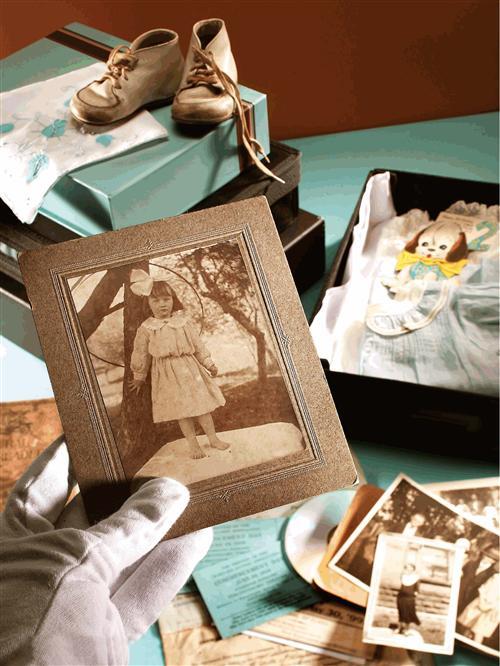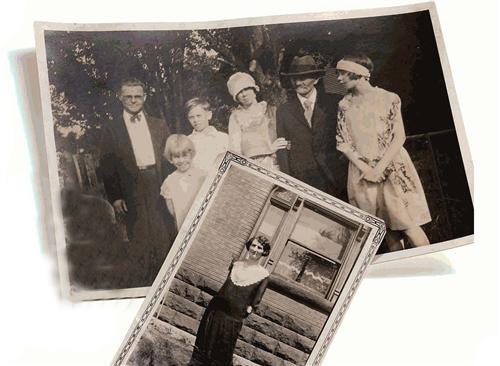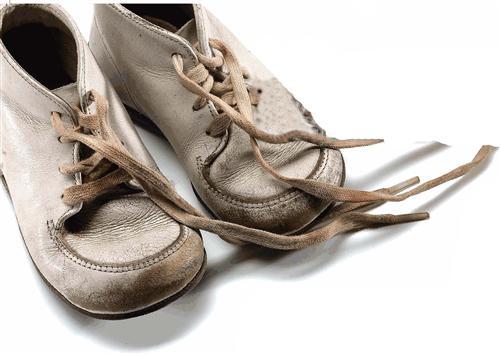Sign up for the Family Tree Newsletter Plus, you’ll receive our 10 Essential Genealogy Research Forms PDF as a special thank you!
Get Your Free Genealogy Forms
"*" indicates required fields
You can’t have it all, they say. You can’t afford to buy that vacation home and spend two weeks there every summer; you can’t surf RootsWeb <rootsweb.com> until 3 a.m. and spring out of bed like a lark at sunrise. You can’t properly preserve the stacks of family papers, mounds of old photographs and heaps of Great-grandma’s quilts and still enjoy them. At least not according to the bombardment of heirloom-safeguarding advice available on the Internet and in magazines and books.
We think differently. The whole point of preserving heirlooms is so you and your descendants can use them to connect with family history. To help you cut through the information overload and determine the best preservation practices, we tapped three experts: Sally J. Jacobs, owner of Jacobs Archival Services and blogger at the Practical Archivist <practicalarchivist.blogspot.com>; Ed Earle, curator at the International Center of Photography (ICP) in New York City <www.icp.org>; and Mary M. Fahey, head of preservation at the Henry Ford Museum <www.hfmgv.org> in Dearborn, Mich. They’ll share the most important tips and products for common types of heirlooms so you can start preserving – and enjoying – your precious memories today.
Preparation pointers
To ensure your documents, photographs and textiles last for generations to come, you first need to protect them from threats such as acidic materials, hungry bugs and improper handling. Wash your hands and put away snacks and drinks to avoid spills, then follow these guidelines:
Paper: The needs of your paper heirlooms, such as marriage certificates, letters and books, are pretty simple, says Jacobs. First, she advises unfolding or unrolling your documents to eliminate creases, which can weaken fibers.
Next, protect paper from one of its chief enemies: acids in storage materials and even the heirloom itself. “The acids created as a result of modern papermaking are like a slow fire that will transform paper into a brown crumbly mess,” says Jacobs.
If your paper mementos are already brown and brittle, nothing will reverse the damage. But you can prevent further damage. Jacobs recommends two options: keeping the document away from other papers and preserving the information on it in another form. Newsprint is extremely acidic, so to save your clipping of Aunt Jennie’s wedding announcement, photocopy it onto archival bond paper.
“While you don’t have the sentimental value of the original piece,” says Jacobs, “you save the information for future generations.” Archival paper is actually pretty robust, she adds. When printed on acid-free paper and stored properly, your paper treasures could last up to 500 years. Make a “handling” copy, too, so you can leave the “preservation” copy alone.
Photos: “Family photographs are sometimes our only connection to the past,” says Earle. But like paper, your ancestors’ pictures are subject to deterioration, including fading and yellowing, if you don’t take steps to prevent it.
How you preserve this visual link to your family history depends on the type of photographs you have. For sepia or black-and-white prints, Earle suggests scanning them and printing copies with a printer that uses pigment inks, not dye. Pigment-based inks withstand light, humidity and temperature variations better than dyes, and have greater longevity. Earle also recommends printing only on good, acid-free photo paper, available from office-supply stores.
Less is best when it comes to early photographs, such as daguerreotypes and tintypes. The former often came in decorative leather or molded plastic cases — as much a part of the artifact as the images. Earle suggests leaving daguerreotypes in their cases and wrapping them with acid-free paper. Tintypes typically didn’t come in cases, so place them directly in acid-free sleeves. If these delicate objects require cleaning or restoring, Earle advises hiring an expert conservator.
To ensure the longevity of digital pictures, Earle suggests you start by getting them off your camera and onto your computer on a regular basis. But don’t just leave them there, he adds – hard drives can crash and take your memories with them. Instead, burn them onto a CD, which is also a good way to organize them. Be sure to choose high-quality archival CDs that are intended for long-term storage. For insurance, duplicate the CD and store it in a separate location. As technology changes, be prepared to update your digital storage medium. Print your digital images on acid-free photo paper with a pigment-based printer to guard against obsolescence.
Textiles: Although the first step in preserving textiles is cleaning them, don’t even think of sending Great-grandpa’s military uniform or Grandma’s hand-sewn patchwork quilt to your favorite dry cleaner. Because dry cleaning chemicals can harm delicate fibers, professional conservators opt to vacuum textiles instead.
It’s a little more time-consuming, but “if you really want to keep it, you’re better off putting the work in,” says Fahey. Gently vacuum both sides of the item using a low-suction vacuum with a clean nozzle covered by a nylon screen (such as the type used for windows). The screen will prevent loose cloth, trims, beads and buttons from getting caught in the nozzle. You can purchase lint rollers (the sticky ones often used to remove pet hair) and microattachments for your household vacuum (such as the kind used to clean computer keyboards) to make the cleaning process easier and prevent damage to smaller items such as hats, handbags and gloves. You can just shake out quilts and other linens as long as they’re not fragile.
Textiles are vulnerable to a variety of pests such as moths, carpet beetles, silverfish, firebrats and mice. Wool and silk attract bugs and mice that snack on the protein in the fibers. Cotton generally doesn’t have infestation problems, says Fahey, but some insects love to feed on heavily starched garments. If you find your favorite heirloom suit, dress or uniform is playing host to a family of critters, isolate it from other clothing and contact a professional conservator to clean it.
Fahey advises paying special attention to framed needlework samplers. These delicate objects are often attached to wood frames with nails, which can harm the fabric (especially when they’re rusted). To preserve such a treasure, you’ll need to carefully remove the sampler from the frame and remount it. If the nails are particularly rusted, or you’re not confident about taking on such a project, seek the help of a professional conservator.
Storage solutions
Once you’ve prepared your heirlooms for safekeeping, don’t store them just anywhere. Exposure to light and the fluctuating temperatures and humidity levels in typical storage spaces – attics, basements and garages – can cause paper to disintegrate, photographs to fade and textiles to fall apart.
You don’t need a sophisticated climate-controlled room, but you will want to choose a dark, stable environment within the living area of your home: About 70 degrees with 50 percent humidity is optimal. Ideal locations, says Jacobs, include an interior closet (closets with outside walls are subject to temperature fluctuations) or under a bed, as long as there’s no vent or radiator nearby. But before you put the items away, follow these guidelines to pack them up:
Paper: Place paper documents in a primary enclosure, such as an archival envelope or folder, then into an archival storage box. Folders not only add sturdy support to your papers, they help everything stay organized. Jacobs suggests keeping letter-sized and smaller folders upright in manuscript boxes, using spacers if necessary to prevent them from falling over.
Flat boxes are best for oversized documents, such as marriage licenses and land titles. Stay away from those clear vinyl sleeves you can purchase cheaply at office supply stores, since the PVCs they contain are chemically unstable. Instead, Jacobs says, you should use Mylar or paper sleeves, folders, envelopes and boxes that are acid-free, lignin-free and buffered with calcium carbonate.
Photos: Similarly, store each photograph in a primary archival enclosure – Earle recommends plastic storage sleeves or albums – inside an archival box. Put CDs containing scanned or digital images inside acid-free sleeves or binders.
Textiles: For long-term clothing storage, you can use an acid-free box or hangers, says Fahey. In a box, roll sheets of acid-free tissue paper and place them under folds so creases don’t set in. If you go the latter route, use a hard plastic hanger padded with polyester batting and covered with unbleached muslin. Avoid flexible plastic hangers, which contain damaging chemicals. Wrap the garment with a dust cover of unbleached muslin. Stuff hats, bags and shoes with acid-free tissue so they’ll retain their shape. Whatever your storage method, inspect textiles at least once a year for pests and other damage.
Display directions
You can preserve your memories and use them, wear them or hang them on your walls. “If you’re not using it and enjoying it, what’s the point?” asks Jacobs. These easy tips will make your displays worry-free.
Paper: To keep your paper treasures on view, Jacobs advises scanning documents and printing high-quality copies for display on the wall or in a scrapbook. Frame them with photo-safe materials so the copies last and you don’t have to keep subjecting the originals to the intense light of a scanner.
Every heirloom has a story to tell. Catalog those tales on our heirloom recording form <www.familytreemagazine.com/sep07/heirlooms.asp>.
Place framed copies out of harm’s way, adds Jacobs – away from direct sunlight, radiators and air conditioning vents. In addition, send copies to relatives. “The more copies of an item, the more likely it is to survive for the long term,” says Jacobs.
Photos: When it comes to mounting and framing photographs for display, Earle has just two key pieces of advice: Use only archival materials for anything that touches the photo, and make sure the glass doesn’t butt against the photo’s surface (emulsion), or it could stick. Framing stores sell spacers to keep that from happening. You also can frame copies of your photos.
Textiles: Museums display textiles on special mannequins made of foam and polyester batting – a relatively expensive option. As an alternative, Fahey suggests arranging clothing on a Plexiglas rod inserted horizontally through the sleeves, or on a padded hanger (like those recommended for storing garments in closets), and placing it away from direct heat and sunlight. People tend to show off quilts and linens by using them, says Fahey. That’s fine, she says, as long as you’re aware that “if you’re going to use it, you’re taking a chance” it could get damaged. Minimize wear and tear by rotating vintage items in and out of use and treating spills immediately.
Don’t let the onslaught of preservation advice overwhelm you, and forget about mothballing your family’s treasures. With a few simple precautions, you can have your heirlooms and enjoy them, too. That vacation home, on the other hand, might be a little more challenging.
ADVERTISEMENT







